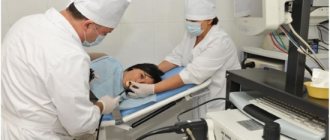For a thorough examination of the peritoneal and pelvic organs, there are a number of invasive and minimally invasive procedures. Diagnostic laparoscopy occupies a special place in gynecological practice and emergency surgery.
Using this manipulation, you can examine the condition of the internal organs, and if necessary, you can immediately stop the bleeding, remove the detected tumor, or perform tissue excision. Laparoscopy of the abdominal cavity is well tolerated by patients. In any case, it is better than laparotomy, which involves a cavity incision.
The likelihood of complications can be reduced if the doctor correctly prescribes the diagnostic procedure, taking into account the relevant indications and contraindications. Laparoscopic examination of the abdominal cavity makes it possible to detect the filling of the abdomen with pathological fluids, identify neoplasms, proliferation of connective tissue cords, and determine the condition of the intestinal loops, pancreas and liver.
What is the essence and advantages of diagnostic laparoscopy
Laparoscopy refers to a minor surgical intervention without the usual incision in the abdominal wall. This minimally invasive (low-traumatic) operation is performed using special endoscopic equipment with an optical system.
A laparoscope is a rigid endoscope equipped with an optical system, a lighting device and precise surgical micro-instruments.
The laparoscope is inserted into the abdominal cavity through micro-incisions. During an operation using it, air is pumped into the abdominal cavity, which improves the visualization of organs and their pathologies. Images of all examined organs are displayed on the screen.
The laparoscope examination is performed under intravenous anesthesia. This operation allows you to examine and directly examine the smallest defects of the pelvic organs.
The method allows you to make an accurate diagnosis and find the optimal treatment method for the identified gynecological disease.
During laparoscopy, a layer-by-layer tissue incision is not made, which significantly facilitates its course and the subsequent postoperative period.
Advantages of diagnostic laparoscopy:
- minimal blood loss;
- short period of hospital stay;
- clear visualization of the organs being examined;
- adhesions are excluded;
- rapid postoperative recovery (usually 3-7 days);
- absence of severe postoperative pain;
- minimal cosmetic defects after the intervention.
New developments - robot surgeon
The first robots capable of assisting surgeons appeared in the 90s. Such devices were imperfect, so many specialists refused to use them. They treated them with particular distrust. Over time, significant progress has been seen in the accuracy and functionality of the equipment, which has made such devices convenient and reliable.
Robotic surgery is widely used in practice. One of the most popular laparoscopic devices is the da Vinci robot, which was developed in the United States. The device operates using a laparoscopic technique using microsurgical elements, but the way they are used differs significantly from conventional surgery.
Such a system consists of the following components:
- control panel for the surgeon;
- an operating table equipped with robotic arms necessary to grasp and operate instruments;
- a sophisticated visualization system with which the assistant monitors the progress of laparoscopy.
The operating console receives a three-dimensional image of the working cavity, which is close to realistic. Micro cameras with the best resolution are used to transmit it. If necessary, the controller can enlarge the image without losing its properties. The workplace is comfortable and designed for long-term operations.
The work is controlled by the surgeon using the system. Doctors are now considering laparoscopy with particular enthusiasm. The system eliminates hand tremors, which are always transmitted to the instruments during laparoscopic and laparotomy operations. The main disadvantage of laparoscopy is its cost: about $1 million. This is not a final price because there are costs associated with maintaining the system and retraining personnel to work with it.
https://youtu.be/JT1b3QHi64o
When is diagnostic laparoscopy performed?
Diagnostic laparoscopy in gynecology is not prescribed for every patient. There must be special reasons for such interference. Most often, this diagnostic method is used if other diagnostic methods have proven ineffective in establishing or clarifying the diagnosis.
Typically, this type of minimally invasive intervention is prescribed for:
- suspected of having an ectopic (ectopic) pregnancy;
- suspicion of a tumor-like process in the ovarian area, to identify the stage of this process (to clarify the possibility and scope of future surgery);
- infertility of unknown etiology;
- the need for a biopsy for newly identified ovarian tumors or polycystic disease;
- clarifying the location and nature of genital abnormalities;
- prolapse or prolapse of the genital organs;
- diagnosis of tubal obstruction in infertility (if other gentle diagnostic methods turned out to be ineffective);
- carrying out sterilization;
- identifying the causes of chronic pelvic pain (especially with endometriosis);
- monitoring the integrity of the uterine wall during operations to excise it (during hysteroresectoscopy);
- study of the effectiveness of treatment of inflammation of the female genital area.
Emergency diagnostics
In addition to planned, in gynecology there is also an emergency (unplanned) type of laparoscopic diagnosis. This type of study is carried out in case of sudden situations that threaten the health or life of a woman.
An emergency diagnostic method may be necessary when:
- Suspicion of the development of acute conditions in the pelvis when clarifying the following diagnoses:
- perforation of the uterus;
- torsion of the cyst legs;
- apoplexy, tumors or necrosis of the ovary or myomatous node;
- rupture of an ovarian cyst;
- continued tubal pregnancy or suspicion of incipient tubal abortion;
- suspected pelvioperitonitis due to inflammatory, tumor or purulent formations in the fallopian tube.
- Symptoms of “acute abdomen” for unknown reasons, including when gynecological pathologies are suspected.
- Lack of effect and increasing worsening condition in the treatment of acute inflammation of the uterine appendages.
- Loss of the intrauterine device inside the body.
Often, simultaneously with diagnosis during laparoscopy, it is also possible to treat the identified pathology. This type of laparoscopy is already therapeutic and can be performed with suturing the uterus, restoring tubal patency, dissecting adhesions, emergency removal of uterine nodes, etc.
It is convenient that such manipulations are performed simultaneously with diagnostic laparoscopy.
Areas of use
The scope of application of da Vinci robots is extensive. They allow complex or atypical laparoscopic operations on the heart, thyroid gland, pelvic organs and abdominal area. Robotic devices are used for various cancer diseases.
It is possible to perform laparoscopy for serious pathologies:
- lung cancer up to stage 4;
- neoplasms of benign and malignant nature in the breast;
- damage to the stomach and other abdominal organs;
- serious gynecological pathologies in women;
- oncological lesions of the prostate and kidneys.
The devices do not yet have universality. Robots do not perform laparoscopic surgery on their own. A surgeon always sits behind the panel and controls the work process. The use of such devices is justified in cases where delicate work is required and hand trembling is unacceptable.
Artificial intelligence can make therapy effective, less traumatic and reduce the risk of complications in patients. A robot is simply the hands of a surgeon, allowing complex operations to be performed while reducing risks during their course.
In oncology
Laparoscopic techniques are widely used in oncology and are considered the best method of fighting tumors. The high information content of the picture received on the monitor reduces the risk of complications. With the help of special instruments, the doctor receives expanded capabilities compared to traditional surgical techniques.
The advantages of laparoscopy are as follows:
- reducing the likelihood of blood loss during laparoscopic surgery;
- the accuracy and efficiency of removal of the neoplasm itself and its metastases increases;
- the recovery period is reduced.
The principle of the laparoscopic method is based on the use of special endoscopic instruments under video control. To ensure laparoscopy in oncology, 3–5 incisions 12 cm long are sufficient. The procedure is always performed under general anesthesia. The recovery period in comparison with open abdominal operations is minimal and comfortable. It should be taken into account that in oncology, the laparoscopic method of surgery can be considered as a single-component and final method of treating a tumor or act as a stage necessary for complex treatment.
The therapeutic regimen largely depends on the nature, volume and aggressiveness of the formation, the general condition of the patient and his medical history. The best results with endoscopic surgery are observed when benign tumors or malignant tumors without metastases are removed at an early stage of development.
https://youtu.be/Z1UT0oidsFo
In gynecology
Robotic surgery is often used in gynecology. The laparoscopic method is used not only for oncological pathologies, but also during the resection of endometrioid infiltrates. The list of operations performed using laparoscopy is quite wide. They can be organ-preserving and radical.
Most often, the da Vinci robot is used in gynecological oncology. It is used to perform: radical hysterectomy, radical trachelectomy, para-aortic lymphadenectomy.
For fluorescence imaging, the firefly system is used. It allows you to identify the location of pathologically changed tissues in real time. To ensure the operation of this system, the patient is injected with contrast, which binds to plasma proteins. In real time, due to the luminescence effect, the surgeon identifies the boundary between malignant and healthy tissues. This makes it possible to completely remove the affected area without affecting healthy tissue. This condition reduces the risk of relapse of the disease.
For diagnostics
The laparoscopic diagnostic method is used in the following cases:
- The patient is concerned about a symptom complex collectively called “acute abdomen.” The condition often manifests itself against the background of injuries, acute diseases and infectious and inflammatory processes.
- Diagnostics of this nature are used for abdominal bleeding and insufficient blood supply to the abdominal organs.
- Indications for diagnostic laparoscopy may include closed abdominal injuries and various lesions. The procedure helps identify penetrating wounds and injuries to internal organs.
- Laparoscopy is used when an accumulation of several liters of fluid in the abdominal cavity is detected due to unknown reasons.
- To detect the causes of aseptic or bacterial infection of the abdominal cavity. Often the laparoscopic method is used to clarify the boundaries of malignant and benign formations and allows to identify the spread of metastases.
The advantage of laparoscopy is not only the ability to diagnose various diseases, but also the ability to collect biological material necessary to determine the nature of the tumor process.
Contraindications for diagnostic laparoscopy
Relative contraindications are considered to be those that are in effect at the moment, but can be overcome. Such contraindications are the following situations:
- suspected malignant neoplasms in the uterus;
- after recent abdominal operations;
- general infectious diseases;
- diffuse peritonitis;
- obesity;
- high degree of exhaustion of the body;
- polyvalent (to several components) allergies;
- pregnancy period over 16 weeks;
- large ovarian tumors (more than 14 cm in diameter);
- expanded uterine fibroids (more than 16 weeks).
Absolute contraindications
- States of shock (including nervous shock) or coma.
- Hemorrhagic shock after acute pathologies (ovarian apoplexy, rupture of a tube or cyst, etc.).
- Stroke, heart attack.
- Chronic pathologies of the cardiovascular or respiratory systems in the stage of decompensation.
- Severe blood diseases (including coagulopathies with uncorrectable coagulation disorders).
- Severe adhesions in the abdominal cavity (after serious interventions or prolonged inflammation).
- Acute renal-liver failure.
- Malignant tumors of the fallopian tubes or ovaries.
- If tilting the head end of the operating table is contraindicated for the patient (after injuries or diseases of the brain, with a sliding diaphragmatic hernia or non-closure of the esophageal hiatus, etc.)
Laparoscopy for diagnostic purposes will not be effective if:
- tuberculosis of the genital organs;
- advanced severe endometriosis;
- the presence of a large number of adhesions in the peritoneal area;
- large hydrosalpinx.
Often, after diagnostic laparoscopy, patients are prescribed laparotomy, which allows the newly identified disease to be cured with minimal trauma.
Consequences of the operation
As already noted, laparoscopy is much easier to tolerate by the female body, and therefore severe consequences and complications after surgery occur extremely rarely. Of course, although the laparoscopic method is considered the safest and most health-friendly today, it is still a surgical operation, followed by a mandatory rehabilitation period. Despite the fact that the patient is in the hospital for no more than 3-7 days, the return to a full, active life occurs much later. As a rule, complications after laparoscopy occur in approximately 5-10% of cases. The most common consequences of laparoscopic surgery:
- Accidental damage to internal organs during surgical procedures. The most common cause of such damage is poor visualization of internal organs.
- Heavy bleeding after surgery.
- Damage to a blood vessel when performing a puncture on the wall of the abdominal cavity.
Recovery after laparoscopy is much faster than with conventional abdominal surgery. As a rule, already 4-5 hours after emerging from anesthesia, a woman is recommended to gradually get out of bed and carefully move around the ward. This is recommended to eliminate possible congestion in the abdominal cavity and pelvis. You should avoid too sudden, intense movements; it is enough to take a few smooth, leisurely steps.
The first day after laparoscopy should be spent in a hospital setting, under strict medical supervision. After laparoscopy, postoperative pain in the lower abdomen may be observed, which can radiate to the lumbar region, sacrum or legs. In such cases, you should definitely report pain to your doctor so that painkillers can be prescribed. Usually, after 3-4 days after surgery, the pain disappears.
On the first day after surgery, eating is prohibited; you are only allowed to drink non-carbonated mineral water.
Also, in the first days of the recovery period after laparoscopy, a woman may feel discomfort, heaviness in the abdomen, nausea - all this is the result of carbon dioxide introduced into the abdominal cavity. Discomfort and other unpleasant phenomena completely disappear after the gas is completely removed from the body. After laparoscopy, there are no rough scars or scars left on the anterior wall of the abdominal cavity, since the sutures heal extremely quickly. Provided there are no complications, the sutures are removed 7-10 days after the operation. This issue is decided by the surgeon on an individual basis. After discharge from the hospital, it is necessary to treat the suture sites with special antiseptic preparations, which the surgeon will recommend.
On the second day after laparoscopy, you are allowed to get out of bed and walk around the ward, and go to the toilet on your own. The recovery period after surgery lasts at least 7-14 days. During rehabilitation, you should follow some of the doctors’ instructions:
- It is strictly not recommended to bathe in the bathroom for 3-4 weeks after laparoscopy. To carry out hygienic procedures, before removing the stitches, you should use wet wipes of the body; after removing the stitches, you are allowed to use the shower.
- For 4-6 weeks after laparoscopy, it is prohibited to visit saunas, steam baths, solariums or swimming pools.
- Sexual activity is also prohibited. Sexual contacts are allowed only 3-4 weeks after surgery.
- After surgery, women are strongly advised to refrain from playing sports or any other physical activity. This recommendation must be followed for at least 4 weeks. Also, for 10-12 weeks after surgery, you should not lift anything heavier than 2-3 kg.
Preparation for laparoscopy
Properly carried out preparatory measures help to avoid serious complications during and after the intervention.
Main stages of preparation:
- The right psychological attitude. You should not be afraid of this manipulation, but you need to be aware of the upcoming difficulties or possible pain. The attending physician, a specially printed “memo”, or competent information from the Internet can help a woman with this. The patient should be aware of possible risks or complications from the insertion of a laparoscope. Correct psychological perception helps to easily endure the procedure itself and the recovery period after it.
- When compiling a patient’s medical history, all previous and existing diseases and her intolerance to certain medications must be taken into account.
- Preparatory activities in the form of consultation with a gynecologist and doctors of other specialties (cardiologist, neurologist, surgeon, etc.) and the necessary hardware studies: MRI, pelvic ultrasound, fluorography (valid for 6 months), electrocardiography (valid for 1 month), X-ray, etc. This may require repeated studies or medical consultations.
- Conducting laboratory research. In this case, 2 weeks before the expected date of manipulation, the patient is prescribed a series of tests: examination for syphilis, HIV and hepatitis (valid for 3 months), vaginal smear for flora (valid for 10 days). No earlier than 10 days before surgery, the patient must also undergo a general urine and blood test, and the blood is examined for coagulability and biochemistry.
- At the same time, the department usually stores blood of the same type and Rh as the patient’s (in case of unexpected complications during laparoscopy).
- Carrying out preparatory drug therapy. Some women during this period (if the prothrombin index is too high) are prescribed blood-thinning drugs. You should not disturb the systematic use of such drugs, as this can cause complications during this manipulation.
- The point about dieting is important. Usually, 2 weeks before the study, the patient is advised to switch to a plant-fermented milk diet. 3-4 days before a laparoscope examination, a woman is advised to exclude from her diet foods that cause bloating and overly burden the digestive system (baked goods, legumes, smoked meats, alcohol, sweets). At the same time, medications that eliminate gas formation (chamomile infusion, activated carbon tablets) are prescribed.
- The day before the study, the patient is recommended to reduce portions of food and liquid. A cleansing enema is also often prescribed. This procedure is all the more necessary since the effect of anesthesia during laparoscopy often has a relaxing effect on the intestines at the time of the examination.
- Before the operation itself, the patient takes a shower with detergents. This also removes hair from the groin area.
- On the day of surgery, the patient should not eat or drink anything.
Some patients consider endoscopic operations to be completely safe. This is largely true, but one should not neglect proper preparation and strictly follow medical prescriptions.
https://youtu.be/jVU6aZ3Ix80
Rehabilitation period
During the first 2–3 hours after laparoscopy, the patient remains in the intensive care unit. Medical staff are monitoring his condition. If everything went well, the patient is transferred to a standard ward, where he must lie in a horizontal position for at least 4 hours.
The first meal is allowed after 24 hours after laparoscopy, and water can be drunk after 5–6 hours. It is allowed to drink only non-carbonated water, in small sips at intervals of 5–10 minutes. The patient can get up slowly, in the presence of staff or loved ones. On the second day after laparoscopic surgery, the patient can walk independently and eat liquid food. During the entire recovery period, it is necessary to exclude any physical activity. Lifting more than 5 kilograms is prohibited for six months.
https://youtu.be/abdoKDT1yJI
Recommendations after the procedure
A list of general recommendations for patients undergoing laparoscopic gallbladder removal includes:
- You should abstain from sexual intercourse for one month;
- review your diet to avoid constipation;
- You can restore sports loads no earlier than after a month, their intensity should increase gradually, at first they should be minimal;
- heavy physical labor, heavy lifting is contraindicated for at least one month after laparoscopy;
- For six months, the patient must follow the recommendations of dietary table No. 5 according to Pevzner.
If all of the above rules are followed, the victim can return to a full life in six months. Physiotherapy ensures a speedy recovery. The course is carried out as prescribed by a doctor a month after the removal of the organ.
Diet
The patient should eat in accordance with the doctor's recommendations. This condition will shorten the rehabilitation period and help the body adapt to new working conditions. The first few months after laparoscopic surgery, the diet should include semi-liquid pureed food, without fats and coarse fiber.
Acceptable use:
- low-fat dairy products;
- boiled lean meat;
- boiled vegetables (beets, carrots);
- various cereals (preferably buckwheat or oatmeal).
Marinades, smoked foods, legumes and white cabbage are strictly prohibited. Increasing the frequency of meals will help to adapt the body to new conditions and restore the flow of digestive processes. You need to eat 5-7 times a day, but in small portions. This will normalize the process of bile production.
Scheme of diagnostic laparoscopy
Typically laparoscopy includes the following steps:
- The patient is given intravenous (in rare cases, local) anesthesia. In this case, the dose is calculated and the choice of drug is made taking into account the age, weight and condition of the patient. Sometimes the patient is connected to an artificial respiration apparatus to ensure complete and regular breaths, eliminating stopping or breathing disturbances.
- The doctor makes a micropuncture with a Veress needle (a device with a needle and a stylet) before inserting the laparoscope. The puncture location depends on the organ being examined (in gynecology, the lower abdomen).
- The patient's abdomen is inflated using a special gas injected. This gas is non-toxic, does not cause allergies and is perfectly absorbed by tissues. The gas used for laparoscopy is usually argon, nitrous oxide or carbon dioxide. This is necessary for convenient movement of instruments in the peritoneum.
- After introducing the gas, the specialist makes an incision and inserts the laparoscope. This is a modern device that does not allow injury to internal organs. Then the specialist makes several holes (in the navel area) for introducing micromanipulators and a video camera. After the instruments are inserted into the abdominal cavity, the camera is connected, which allows you to obtain an enlarged image of the organs being examined on the screen.
- The surgeon examines the necessary organs. The examination time can take from 10 minutes to an hour. Particular attention is paid to examining adhesions, pathological formations, and fluid.
- If this is necessary, a biopsy of the changed area of the organ is performed and a section of its tissue is taken for histological examination. In some cases, the cyst is also punctured and fluid is taken from it to be sent to the laboratory.
- At the end of the procedure, drainage must be installed. This is necessary for the free release of pathological fluids (blood residues, contents of ulcers, discharge from wounds). This is necessary to prevent peritonitis due to the entry of contents with pathogenic microflora into the abdominal cavity.
Laparoscopic gallbladder surgery
Laparoscopy is characterized by increased efficiency and low trauma to the pelvic and abdominal organs. In recent years, laparoscopic intervention in the peritoneum has become popular and widespread.
Laparoscopic surgery is indicated for cholelithiasis. Laparoscopy will help reduce the risk of complications and restore the body in a short time. Afterwards, invisible scars remain on the patient’s body, since insertion of instruments requires punctures no longer than 2 cm.
The list of indications for laparoscopy can be presented as follows:
- acute pain syndrome disturbing the patient;
- asymptomatic course of the disease;
- choledocholithiasis, in which blockage and inflammation of the ducts occurs;
- acute cholecystitis;
- gallbladder polyposis and cholesterosis.
Laparoscopy is performed in the department of general surgery or gastroenterology. It is provided by the operating doctor. The process itself takes from 45 minutes to 1.5 hours.
https://youtu.be/MNMuShGM-60
Alternative types of research
Hysteroscopy and transvaginal hydrolaparoscopy are also used to diagnose pelvic pathology in women. What are their characteristics?
Hysteroscopy is similar to diagnostic laparoscopy, but the instrument to examine the reproductive organs is inserted through the vagina. Then the instruments necessary for the study are inserted through the cervix into the uterine cavity. The image of all organs is also transmitted through a video camera to the monitor screen.
This procedure allows you to examine the pelvic organs, including the uterus and cervical canal. In addition, hysteroscopy does not require preparation and has almost no contraindications.
Hysteroscopy is often used simultaneously with diagnostic laproscopy. This allows for simultaneous diagnosis of the pathology and its necessary treatment. With hysteroscopy it is also possible to perform minor surgical interventions.
The modern study called “transvaginal hydrolaparoscopy” is not known to everyone. This type of diagnosis is used for a detailed examination of the internal reproductive organs. In this case, a special probe is inserted into the uterus through micro-incisions, which allows you to examine the organs of the reproductive system with micro-operation, if necessary.
Types of laparoscopic operations and indications for them
Laparoscopy of the abdominal cavity is of 2 types: diagnostic and therapeutic, and can also be planned and emergency.
Planned manipulation is carried out when:
Neoplasms on the kidney are also removed laparoscopically.
- tubal, peritoneal infertility;
- cystic neoplasms;
- adenomyosis;
- improper formation of the genital organs;
- pain in the lower epigastric region of unknown etiology;
- to create artificial obstruction of the fallopian tubes.
Emergency has the following indications:
- ectopic pregnancy;
- ovarian hemorrhage or infarction;
- torsion or rupture of the stem of the tumor process;
- differential diagnosis between acute surgical or gynecological disease;
- inflammation of the peritoneal and pelvic organs.
Diagnostic laparoscopy for infertility
Often, women who are unsuccessfully trying to become mothers, after ineffective treatment, are offered a diagnostic laparoscopy.
Sometimes during laparoscopy, the doctor simultaneously performs the following operations:
- restoration of patency of the fallopian tubes (sometimes this increases the risk of ectopic pregnancies);
- in case of ectopic pregnancy - removal of the fertilized egg while preserving the uterine (fallopian) tubes with the fullness of all their functions;
- dissection of adhesions between internal organs that interfere with normal reproductive function;
- for endometriosis – removal of heterotopia (fragments of overgrown endometrium), which often allows restoring female fertility.
Methods to combat the main complication
The most intrusive and unpleasant condition after laparoscopy is pain, a feeling that the navel or lower abdomen is pulling. Doctors suggest coping with these conditions with the help of medications:
- opiates – are practically not prescribed due to side effects and interfere with the timely diagnosis of complications;
- NSAIDs are effective means to combat unpleasant sensations;
- non-narcotic analgesics - can be combined with NSAIDs or used separately.
All doctors recommend to patients: if the pain is moderate, it is better to endure it and stop taking analgesics.
Possible complications of diagnostic laparoscopy
The most common complications of diagnostic laparoscopy:
- injuries to the intestines, reproductive organs or urinary organs;
- gas embolism;
- internal bleeding;
- hernia formation;
- respiratory or cardiac problems;
- damage to blood vessels or abdominal organs;
- thrombosis or damage to peritoneal vessels;
- subcutaneous emphysema (accumulation of gas in the subcutaneous layer of fat).
Typically, complications after laparoscopy are associated with improper preparation for the intervention, underestimation of contraindications, or low professional level of the doctor.
Some complications resolve on their own, while others require medication or surgery.
Diagnostic laparoscopy is a modern and extremely safe type of examination. The diagnostic introduction of a laparoscope can work wonders by revealing previously unexplored causes of most serious gynecological diseases.
https://youtu.be/z8fF_R0SeQU
Possible complications after laparoscopy
This type of surgical intervention is performed when it is necessary to remove an internal organ or a pathologically altered part of it.
To carry it out, the specialist makes a small incision and passes trocars and a laparoscope inside, through which the operation is performed. In some cases, this method is also used as a diagnostic method.
It is most often used in gynecology to fully preserve the ability of young women to bear children. With the help of this operation, adhesions, cysts, and benign neoplasms are removed. Laparoscopy allows you to eliminate the consequences of an ectopic pregnancy and restore tubal patency. Usually, immediately after surgery, patients experience some unpleasant sensations in the form of pain in the surgical area, decreased motor activity, and lack of appetite.
But more complex negative consequences of laparoscopy are usually divided into early and late.
The first group includes:
- pain;
- dyspeptic symptoms;
- flatulence;
- migraine;
- swelling;
- nausea;
- allergic reaction;
- difficulty breathing , etc.
Immediate medical attention requires diarrhea after laparoscopy, vomiting, severe hyperthermia or excessive pain during the first 24 hours after surgery.
The patient's sutures sometimes begin to fester, an infection develops, or an inflammatory process develops.
Late complications most often include thromboembolism, vascular sclerosis, and bleeding.
Medical attention is urgently needed if a suture breaks after laparoscopy. You should not miss signs of inflammation of postoperative scars, the formation of a hernia or ulcers.
OPTIMUM TIME FOR LAPAROSCOPY
The mentioned surgical and diagnostic method in gynecology is not always effective. Why? Inexperienced doctors incorrectly determine the date of intervention. IVF doctors do not make such mistakes. Specialists in the field of reproductive health and gynecology are well aware that the effectiveness of the method depends on what day of the menstrual cycle the operation is scheduled for.
Attention! Infection, internal bleeding or other complications may occur after laparoscopy done during menstruation.
Our specialists prescribe the operation immediately after ovulation. The equator of the monthly cycle is the optimal period for laparoscopy. It is after ovulation that the cause of infertility becomes clear. Other clinical symptoms of diseases known in gynecology are also clearly visible.
What is uterine laparoscopy and its benefits?
A large number of patients in gynecological clinics undergo in-depth examination. Using a laparoscopic device, you can not only perform a full-fledged surgical intervention, but also make high-quality diagnostics. This method is often resorted to if a woman suffers from infertility.
If a doctor prescribes laparoscopy for a woman of reproductive or menopausal age, this indicates a serious illness and the impossibility of conservative treatment.
Laparoscopy to remove the uterus, despite its radical nature, gives the maximum sparing effect. The risk of bleeding during treatment is minimal, and the recovery period is significantly reduced due to minor incisions.
After laparoscopy, the patient’s condition quickly improves, and after 2 weeks she returns to normal.
After removal of an organ, it is impossible to carry a child to term. But maintaining health at the same time gives a chance for a full life. According to numerous reviews, after the operation for laparoscopic removal of the uterus, the patient’s condition quickly improves, and after 2 weeks she returns to normal. If the doctor decides to keep the ovaries, they will continue to produce hormones. Therefore, sudden early menopause is practically excluded.
Types of operations
- Laparoscopy in the cervix. Required for surgical interventions performed through vaginal access. Due to the small incision in this area, visibility is impaired, so an additional instrument with a camera is inserted through the abdominal cavity.
Surgery in the cervix.
- Laparoscopy of the fallopian tubes. It can be used for ligating organs during sterilization, as well as for expanding the lumen of the appendages during infertility treatment. Thanks to laparoscopic intervention, it is possible to eliminate the adhesions in the tubes.
It is used for organ ligation, as well as during the treatment of infertility.
Abdominal surgery to remove the uterus or other elements. The course of the operation may change if complications arise during laparoscopy or health-threatening conditions are discovered - peritonitis, cancer, abscess, heavy bleeding. In such cases, there is a transition from laparoscopy to laparotomy.
Possible complications
The laparoscopy technique is extremely complex; it requires an experienced specialist with well-developed skills. Adverse consequences may occur due to incorrect insertion of trocars. In this case, there may be injuries to internal organs such as the intestines, bladder, ureters, and blood vessels. Most of these complications are resolved immediately during surgery; sutures are placed on the affected organs. If organ injuries cannot be eliminated by laparoscopy, the doctor is forced to perform a laparotomy - opening the anterior wall of the abdomen.
Improper preparation of the patient increases the risk of negative consequences. Thus, a full bladder is very often damaged when instruments are inserted. In this case, in addition to the main operation, the patient is urgently given two rows of sutures on the affected organ. If the patient took medications before the procedure and did not warn the doctor about this, the composition of these drugs can unpredictably affect anesthesia. In some cases, the invasion has to be completed urgently. However, such consequences occur with any surgical intervention.
With laparoscopy, the risk of infection, suture dehiscence, and adhesions is significantly lower.
Indications
Laparoscopic hysterectomy can be used for:
- combination of cervical diseases (scars, hypertrophy, ectropion, precancerous changes) with multiple fibroids;
- recurrent or atypical endometrial hyperplasia in women over 40 years of age;
- adenomyosis;
- uterine cancer, multiple or atypical polyps;
- An emergency operation is performed after childbirth, when the placenta accreta does not detach or the myometrium cannot contract.
Removal of the uterus and ovaries by laparoscopy is used for progressive ovarian tumors, a combination of sclerocystic disease or apoplexy of the ovaries with a tumor of the uterus, purulent inflammation of the ovary, when the uterine tissue and neighboring organs are involved in the purulent melting.
The operation is performed laparoscopically through small (usually 0.5-1.5 cm) holes
In women over 50 years of age, hysterosalpingo-oophorectomy is performed when there is heavy uterine bleeding or tumor growth in one of the reproductive organs. Hysterectomy and removal of one or two appendages are performed for patients in the older age group who are at risk for developing a malignant tumor.
“Removal of the uterus” refers to the varying scope of the operation, which depends on the disease:
- Supravaginal amputation. This is the name for removing the body of the uterus, when its cervix and appendages remain in place. It is performed for large-volume fibroids, adenomyosis, postoperative complications and an atypical form of endometrial hyperplasia, heavy uterine bleeding and pelvic pain, when the cause of these phenomena is not clear.
- Total hysterectomy. In this case, both the body and the cervix are removed, but the tubes and ovaries remain in place. This intervention is performed for endometrial cancer.
- Radical hysterectomy. This is called removal of the uterus and appendages. The method is applicable only if a cancerous tumor is detected that spreads to one of the appendages. If the cancer spreads from the body to the cervix, the initiated laparoscopic intervention is expanded to laparotomy. Not only the uterus, its cervix, tubes and ovaries are removed, but also the inguinal and pelvic lymph nodes, and often the upper parts of the vagina.
The older the woman, the more doctors are inclined to perform more radical surgery. Gynecologists in the USA even perform removal of the uterus along with the cervix in women over 40 years of age who do not have diseases of the reproductive system. Thus, they say, the risk of developing high-grade ovarian cancer is reduced by more than 3.5 times. This is especially important for those who are hereditarily predisposed to the development of cancer, including breast cancer.
LIST OF INDICATIONS
Patients should find out the cost of laparoscopy in gynecology and prepare for it if:
- infertility, the cause of which has not been identified;
- chronic pain in the pelvic area;
- adhesive pathology;
- ectopic pregnancy;
- endometriosis;
- lack of positive results of hormonal therapy for infertility;
- cyst;
- internal bleeding;
- uterine fibroids;
- sclerocystosis, tumors or torsion of the ovaries;
- rupture of the fallopian tubes.
Preparation for the procedure will also be of interest to those patients who cannot make a diagnosis without a detailed examination of the pelvic organs using manipulative instruments.
Consequences and complications
After such a complex procedure as a hysterectomy, the usual consequences are the cessation of menstruation and the inability to become pregnant.
If, in addition to the uterus, the ovaries were also removed, in the first 20 days after the operation, symptoms of menopause are observed: sweating, hot flashes, tearfulness, insomnia. If you do not take hormones that will imitate the work of your own ovaries, after a while problems with the cardiovascular system will appear, cystitis, dryness and itching of the vagina will often begin to bother you. Any injury to the limbs can lead to their fracture (due to osteoporosis), periodontal disease develops, and over time the functioning of the thyroid gland is disrupted, which further aggravates the quality of life.
After removal of the uterus using the laparoscopic method, various complications can be observed: bleeding, suppuration, formation of adhesions, constipation, urinary incontinence, severe pelvic pain, blood poisoning (sepsis).
Recommendations after the procedure
Rest is recommended in the first few hours after the infestation. The duration of bed rest depends on the degree of complexity of the operation, the presence of complications, and the patient’s condition. The attending physician will determine the time of the rehabilitation period and the date of discharge and give recommendations. At home, it is important to fully follow your doctor’s advice. Recommendations may include nutritional rules, if laparoscopy was performed on the gastrointestinal tract, in which case you will have to follow one of the Pevzner diets for 2 weeks. Within a month after the invasion, regardless of its type and purpose, alcohol, too fatty and spicy foods, spicy, and canned foods are excluded.
Personal hygiene is very important. You can swim in the shower, take baths only after 14 days. After each exercise, you need antiseptic treatment of the sutures and a dressing or bandage. For wound treatment it is allowed to use:
- hydrogen peroxide 3%;
- fucorcin;
- alcohol solution of brilliant green.
The sutures are removed on the day determined by the doctor, usually after 7-14 days. This should only be done by a health worker in the dressing room. In the first month after the procedure, you need to limit physical activity, exclude sports and heavy lifting. Leisurely strolls are allowed. You should also abstain from sex for the first 14-30 days, depending on the illness. After examination by a doctor and with his permission, you can return to your normal lifestyle.
If during the rehabilitation period frequent abdominal pain appears, consciousness becomes confused, vomiting occurs, and bowel movements are disrupted, you should inform your doctor about this. It is also important to monitor the condition of the stitches; there should be no swelling, redness, itching, or any discharge.
Preparation
In gynecology, laparoscopy can be prescribed routinely or performed urgently. In the latter case, there will be practically no preparation, because gynecologists will strive to save the patient’s life, and this situation does not involve a long collection of tests. Immediately before the operation, the patient's blood and urine are collected, if possible, and studies are carried out after the fact, after laparoscopy. When performing laparoscopy as planned, preparation includes collecting data on the patient’s current condition and restricting the diet.
Analyzes
Patients are surprised by the extensive list of necessary tests before laparoscopy, but before any abdominal gynecological surgery it is necessary to do the following tests:
- take a blood test, as well as conduct blood tests for sexually transmitted diseases, syphilis, AIDS, hepatitis, ALT, AST, the presence of bilirubin, glucose, assess the degree of blood coagulation, establish the blood group and Rh factor;
- pass OAM;
- make a general smear from the walls of the cervix;
- conduct an ultrasound of the pelvic organs, take a fluorogram;
- provide the gynecologist with a statement about the presence of chronic ailments, if any, and notify about the medications you are constantly taking;
- do a cardiogram.
When the gynecologist receives all the research results, he checks the possibility of performing laparoscopy on a predetermined day, specifying the scope of the future gynecological operation or diagnostic examination. If the gynecologist gives the go-ahead, then the anesthesiologist talks with the patient, finding out if she has an allergy to narcotic drugs or contraindications to general anesthesia during the procedure.
Diet before laparoscopy in gynecology
In gynecology, there are the following dietary rules before laparoscopy:
- 7 days before laparoscopy, you should abstain from any foods that stimulate gas formation in the stomach and intestines - legumes, milk, some vegetables and fruits. The intake of lean meat, boiled eggs, porridge, and fermented milk products is indicated.
- For 5 days, the gynecologist prescribes the use of enzymatic agents, activated carbon, to normalize digestion.
- The day before the procedure, you can only eat pureed soups or liquid porridges; you cannot have dinner. You need to do a cleansing enema in the evening if the gynecologist prescribed it.
- Immediately before laparoscopy, you should not eat or drink anything to keep your bladder empty.
Laparoscopy is a therapeutic and diagnostic procedure that is performed to identify and eliminate diseases of the internal organs without a scalpel. What is the preparation for laparoscopy in gynecology, what should the patient do on the eve of the procedure? We will consider these questions in detail in the article.











